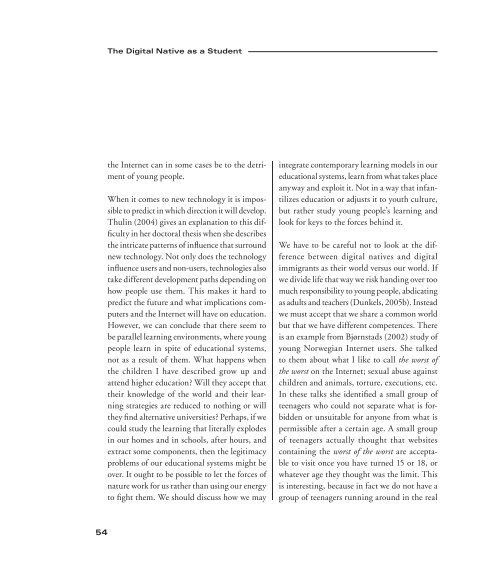idskrift för lärarutbildning och forskning - DiVA
idskrift för lärarutbildning och forskning - DiVA
idskrift för lärarutbildning och forskning - DiVA
Create successful ePaper yourself
Turn your PDF publications into a flip-book with our unique Google optimized e-Paper software.
The Digital Native as a Student<br />
the Internet can in some cases be to the detriment<br />
of young people.<br />
When it comes to new technology it is impossible<br />
to predict in which direction it will develop.<br />
Thulin (2004) gives an explanation to this difficulty<br />
in her doctoral thesis when she describes<br />
the intricate patterns of influence that surround<br />
new technology. Not only does the technology<br />
influence users and non-users, technologies also<br />
take different development paths depending on<br />
how people use them. This makes it hard to<br />
predict the future and what implications computers<br />
and the Internet will have on education.<br />
However, we can conclude that there seem to<br />
be parallel learning environments, where young<br />
people learn in spite of educational systems,<br />
not as a result of them. What happens when<br />
the children I have described grow up and<br />
attend higher education Will they accept that<br />
their knowledge of the world and their learning<br />
strategies are reduced to nothing or will<br />
they find alternative universities Perhaps, if we<br />
could study the learning that literally explodes<br />
in our homes and in schools, after hours, and<br />
extract some components, then the legitimacy<br />
problems of our educational systems might be<br />
over. It ought to be possible to let the forces of<br />
nature work for us rather than using our energy<br />
to fight them. We should discuss how we may<br />
integrate contemporary learning models in our<br />
educational systems, learn from what takes place<br />
anyway and exploit it. Not in a way that infantilizes<br />
education or adjusts it to youth culture,<br />
but rather study young people’s learning and<br />
look for keys to the forces behind it.<br />
We have to be careful not to look at the difference<br />
between digital natives and digital<br />
immigrants as their world versus our world. If<br />
we divide life that way we risk handing over too<br />
much responsibility to young people, abdicating<br />
as adults and teachers (Dunkels, 2005b). Instead<br />
we must accept that we share a common world<br />
but that we have different competences. There<br />
is an example from Bjørnstads (2002) study of<br />
young Norwegian Internet users. She talked<br />
to them about what I like to call the worst of<br />
the worst on the Internet; sexual abuse against<br />
children and animals, torture, executions, etc.<br />
In these talks she identified a small group of<br />
teenagers who could not separate what is forbidden<br />
or unsuitable for anyone from what is<br />
permissible after a certain age. A small group<br />
of teenagers actually thought that websites<br />
containing the worst of the worst are acceptable<br />
to visit once you have turned 15 or 18, or<br />
whatever age they thought was the limit. This<br />
is interesting, because in fact we do not have a<br />
group of teenagers running around in the real<br />
54

















